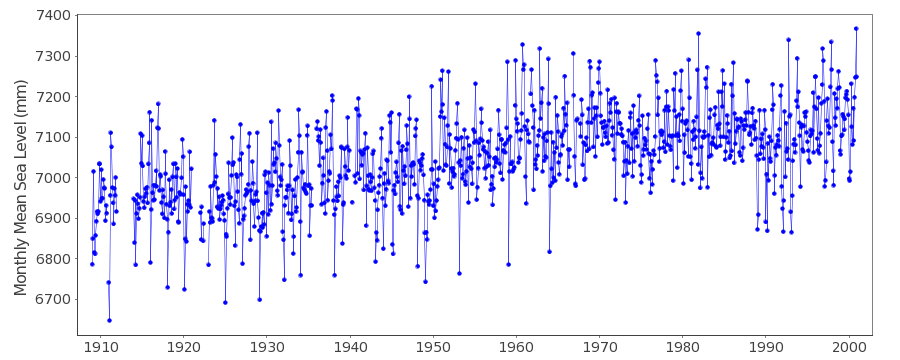The latest “here comes the flood” entry in the climate scare is that Venice has become wet. Famously “The Floating City”, “The City of Canals” and so forth, Venice has 118 islands and over 400 bridges in a lagoon, and the sea surface is never far away. This year it had the highest flood since 1966 which means, well, you know: “The high tide calamity has raised deep concerns over the consequences of rising sea levels for a city that sees itself as being in the front line of the climate change battle.” But if climate change is to blame it must mean sea level rise is accelerating, right? And yet tide gauge data say it’s been slowing down since the 1970s. Maybe you’re just living in a swamp.
The sea level record goes back to 1910 and it tells a simple story: 
Sea levels rose up to the late 1960s and then more or less stopped. So there’s nothing new about rising sea levels in the Venetian lagoon; what’s new (relatively) is that it has been rather slow the past few decades.
Perhaps for that reason the city got lax about upgrading the barrier system that is intended to protect it from future flooding. Naturally when the floods hit, rather than accept the blame, local politicians reflexively blamed climate change. But the swamp thing matters because according to one study, on average the sea has been rising in Venice by about 1 millimetre per year (give or take .3) since 1870, the same as the Mediterranean as a whole, and is rising only slightly faster now than in the 16th to 18th centuries. Other studies using various clever reconstruction methods suggested that sea levels were 12 to 21 cm higher in the Medieval era than today. There’s that darn Medieval Warm Period again. Weren’t you told to go away?
It's surprising just how much climate change alarmism, with its famous “don’t you believe the science” challenge, is based less on bad data than on none. Yet data are available. And Venice, like just about everywhere, has seen a continuation of the gradual rise in sea levels that has been going on for thousands of years, since the more rapid one at the end of the last glaciation.
Venice is in trouble, with under a third the inhabitants it had in 1945, possibly driven away by 20 million tourists a year. Unfortunately Venice has also been sinking by about 1.5 millimetres per year (again give or take .3) which is mighty hard to blame on “climate change”. It’s just what happens when you build a city on log pilings in a swamp. Always was. Always will be.
Yes, always was. That study of rising seas and sinking stones also looked at the now-submerged steps of late medieval palaces and made the amazing discovery that “relative sea level in Venice was always rising at an increasingly fast rate. In fact, the results suggest a turning point in the change of absolute sea level for the mid fifteenth century, quite consistent with the literature: sea level must have dropped from a maximum elevation during the Mediaeval Warm Period, when absolute sea level was 12 to 21 cm higher than today, to a minimum around 1730, as a result of the Little Ice Age. Since the Little Ice Age global warming has led to an accelerated sea level rise, which is illustrated by the long-term data set for Venice.” Medieval Warm Period? Little Ice Age? Can it be natural fluctuations? Say it ain’t so.
It is so, kid. The situation today seems worse than in the 1920s, due in significant measure to the land sinking. But water levels aren’t out of line with where they’ve been since the 1960s, and while they’re higher than in the 1990s it’s because they fell sharply in the late 1980s. Just when climate change really kicked in and sent the seas surging to… never mind.


